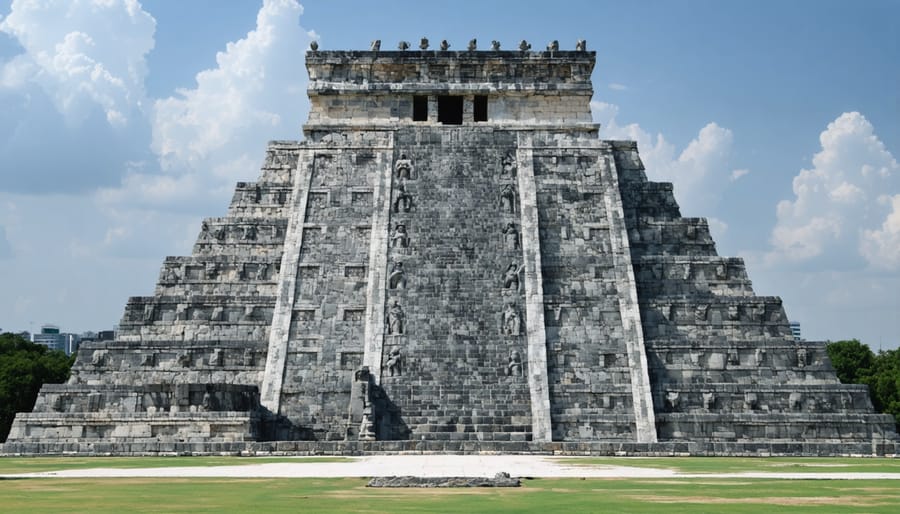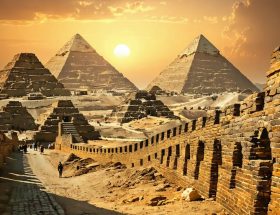Towering above ancient Mesoamerican cities, Aztec stone sculptures stand as masterpieces of stone artistry in architecture, embodying both divine reverence and imperial might. These monumental works, carved from volcanic basalt and precious serpentine, transformed raw stone into powerful symbols of Aztec cosmology and political authority. Master sculptors wielded obsidian tools to create intricate reliefs and free-standing figures, demonstrating unprecedented precision in stone craftsmanship that continues to influence architectural design today. From the colossal Sun Stone calendar to the fearsome Coatlicue statue, these masterpieces reveal sophisticated engineering methods that enabled the Aztecs to quarry, transport, and carve massive stone blocks without metal tools or wheel technology. Their technical achievements in stone manipulation, combined with deep symbolic meaning, created an architectural legacy that bridges ancient ceremonial practices with modern architectural innovation.
Sacred Stone: The Role of Sculptures in Aztec Temple Design
Architectural Integration Techniques
The Aztecs demonstrated remarkable mastery in architectural stone integration, particularly in their temple complexes. Sculptures were not merely decorative elements but integral components of the building structure itself. The most common technique involved carving reliefs directly into the temple walls, creating a seamless fusion between art and architecture.
Large-scale sculptures were typically positioned at strategic points along the temple stairs, serving both aesthetic and functional purposes. These pieces were carefully anchored into the building’s foundation using a sophisticated mortise and tenon system, ensuring structural stability while maintaining visual harmony.
The Aztec architects employed a hierarchical placement system, with the most important sculptures positioned at higher elevations or central locations. They utilized the natural properties of different stone types, selecting harder materials like basalt for load-bearing sculptural elements and softer stones for detailed decorative pieces.
This integration method not only enhanced the temples’ visual impact but also contributed to their structural integrity, demonstrating the Aztecs’ deep understanding of both artistic design and engineering principles.
Symbolic Placement and Orientation
The Aztecs meticulously positioned their stone sculptures according to celestial alignments and religious beliefs, creating a sacred architectural language throughout their temples and ceremonial spaces. Each sculpture’s placement was deliberately chosen to maximize its spiritual significance and connection to specific deities.
Major sculptures typically faced east, welcoming the rising sun and symbolizing renewal and divine energy. Temple entrances were often flanked by serpent sculptures, their heads pointing toward cardinal directions to guard sacred spaces. The positioning of warrior and deity sculptures on different temple levels represented the Aztec cosmos, with higher placements indicating closer proximity to the celestial realm.
Sculptures were frequently oriented to align with significant astronomical events, such as solstices and equinoxes. This precise positioning allowed sunlight to create dramatic shadows and illumination effects during important religious ceremonies. The careful arrangement of sacrificial stones and ritual sculptures near temple summits facilitated the Aztecs’ belief in maintaining cosmic order through ceremonial practices.
These placement principles continue to influence modern archaeological understanding and inform contemporary interpretations of Aztec architectural design.
Material Selection and Stone Working Methods
Stone Types and Their Properties
The Aztecs carefully selected specific types of stone for their sculptures based on both practical and symbolic considerations. Basalt, a dark volcanic rock abundant in the Valley of Mexico, was their primary choice due to its durability and resistance to weathering. This dense material proved ideal for large-scale monuments and architectural elements that needed to withstand centuries of exposure to the elements.
Tezontle, a reddish volcanic rock with a porous texture, was frequently used for smaller sculptures and decorative elements. Its lighter weight made it easier to work with, while its distinctive color added visual interest to architectural compositions. The Aztecs also valued andesite, another volcanic stone, for its workability and ability to hold fine detail in relief carvings.
For more prestigious sculptures, particularly those depicting deities and rulers, the artisans preferred materials like serpentine and jade. These green-hued stones held deep spiritual significance, representing water, vegetation, and life itself. Diorite and granite, though harder to carve, were chosen for their impressive appearance and longevity.
The Aztec sculptors developed sophisticated techniques for working with each stone type, using stone and obsidian tools to achieve remarkable precision. They understood how different stones would react to carving techniques and chose materials that would best serve their artistic and architectural intentions while maintaining structural integrity.
Carving Techniques and Tools
The Aztecs demonstrated remarkable stone craftsmanship techniques in their sculptural works, utilizing a variety of tools and methods that showcase their advanced understanding of stone manipulation. Their primary implements included stone hammers, chisels made from harder stones like basalt, and abrasive materials such as sand and water for finishing surfaces.
Craftsmen typically began with rough-cutting techniques using larger hammerstones to establish the basic form. They then progressed to more precise tools for detailed work, including smaller hammers and pointed chisels for intricate carving. The most common materials they worked with were basalt, andesite, and various types of volcanic rock, each requiring specific approaches due to their different hardness levels.
One distinctive technique involved scoring the stone’s surface with obsidian blades to create preliminary guidelines before deeper carving began. This method allowed artisans to achieve remarkable precision in their sculptural details. For smoothing and polishing, craftsmen used wet sand and leather strips, creating the characteristic smooth finish seen on many Aztec sculptures.
The tools were regularly maintained and resharpened using specialized grinding stones, ensuring precise cuts and detailed work. Evidence suggests that some sculptures required months or even years to complete, demonstrating the meticulous nature of Aztec stone carving practices.
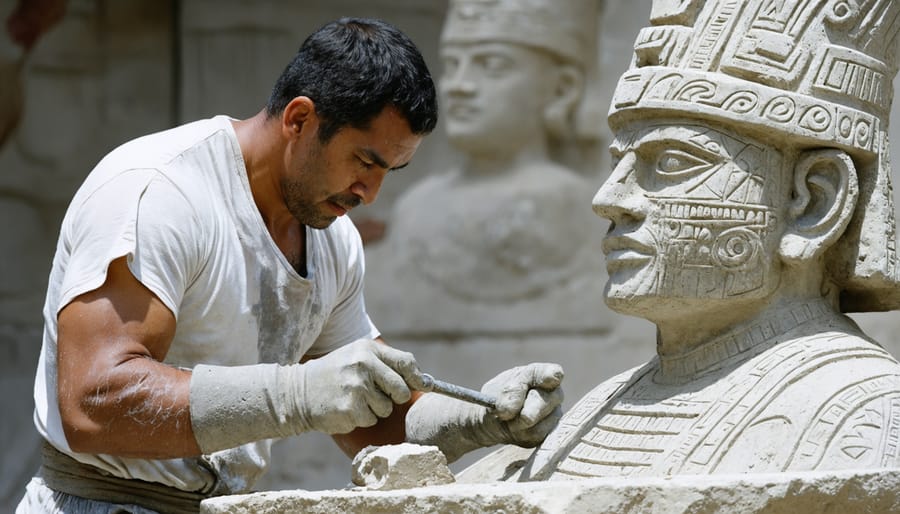
Famous Temple Sculptures and Their Stories
The Calendar Stone
The Calendar Stone, also known as the Sun Stone or Piedra del Sol, stands as one of the most recognizable Aztec sculptures ever created. This massive basalt disk, measuring 11.75 feet in diameter and weighing 24 tons, serves as a sophisticated astronomical calendar and religious symbol.
At its center, the stone features the face of the sun god Tonatiuh, surrounded by four squares representing previous world ages in Aztec cosmology. Each square contains symbols of how these ages ended – by jaguars, wind, rain of fire, and floods. The central face is shown with a sacrificial knife protruding from its tongue, symbolizing the need for blood offerings to sustain the sun’s journey across the sky.
Encircling these elements are twenty day signs of the Aztec calendar, followed by rays of sunlight extending to the stone’s edge. The sculpture also incorporates two fire serpents meeting face-to-face at the bottom, representing the daily cycle of the sun.
Originally painted in vibrant colors, this masterpiece of stone carving demonstrates the Aztecs’ advanced understanding of astronomy and mathematics. The Calendar Stone served both practical and ceremonial purposes, helping track important dates while embodying the Aztec worldview of cyclical time and cosmic order.
Discovered in 1790 near Mexico City’s central square, this monumental sculpture now resides in the National Museum of Anthropology, where its intricate relief carving continues to amaze visitors and scholars alike.
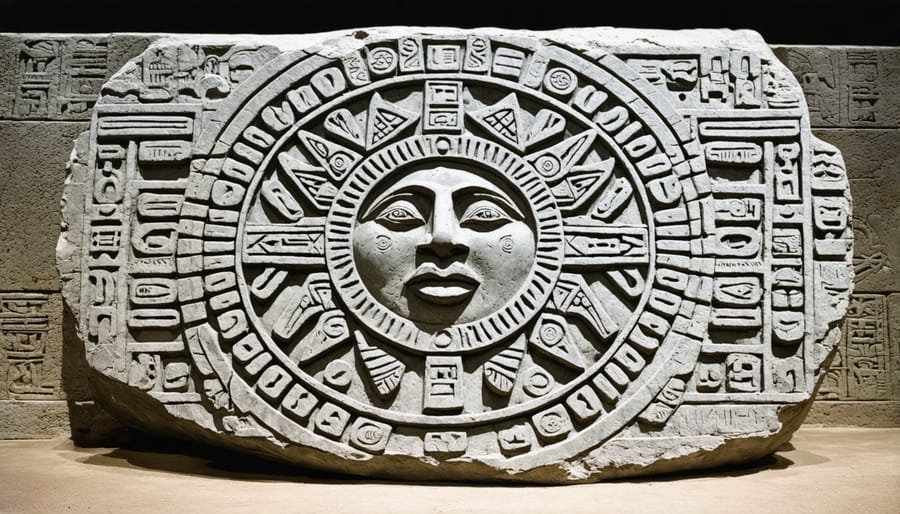
Coatlicue and Temple Guardians
Among the most impressive Aztec stone sculptures, the monumental Coatlicue statue stands as a masterpiece of religious artistry and architectural integration. Standing over 8 feet tall and carved from a single basalt block, this fearsome representation of the earth goddess showcases the Aztecs’ exceptional stone-working capabilities. The statue’s intricate details, including its serpentine skirt and necklace of human hearts, demonstrate the sophisticated carving techniques used by Aztec sculptors.
Temple guardians played an equally vital role in Aztec architectural design, with massive stone sculptures flanking temple entrances and stairways. These guardian figures, often depicting eagles, jaguars, and serpents, were strategically positioned to create an imposing atmosphere while serving practical architectural functions. The sculptures were typically carved from locally sourced volcanic stone, chosen for its durability and symbolic connection to the earth deities.
The integration of these sculptures into temple architecture followed strict religious and aesthetic principles. Guardians were precisely aligned with astronomical events and cardinal directions, reflecting the Aztecs’ deep understanding of both architectural planning and celestial movements. The stone surfaces were often painted in vibrant colors, though only traces remain today, and featured complex relief patterns that enhanced their visual impact while protecting the stone from weathering.
Modern archaeological studies reveal that these sculptures were anchored into temple foundations using innovative stone-fitting techniques, ensuring their stability through centuries of environmental exposure and seismic activity.
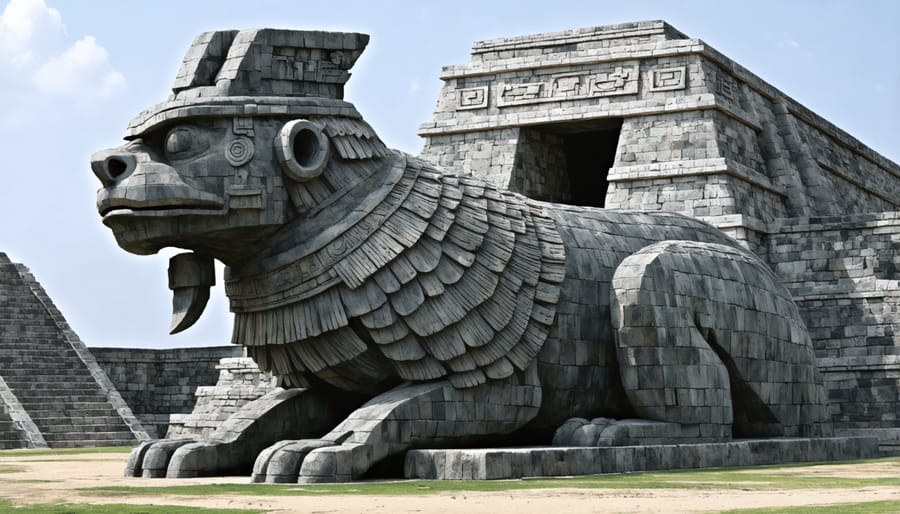
Modern Preservation and Influence
Conservation Challenges
Aztec stone sculptures face significant preservation challenges in the modern era. Environmental factors, particularly acid rain and urban pollution, gradually erode these ancient masterpieces, while temperature fluctuations cause microscopic cracks that worsen over time. Mexico City’s unstable soil conditions also pose risks, as ground settling can affect the structural integrity of these monumental pieces.
Conservation efforts focus on documenting sculptures using 3D scanning technology, allowing preservationists to track deterioration patterns and plan interventions effectively. Specialized cleaning techniques remove harmful deposits without damaging the stone’s patina, while modern consolidants help strengthen weakened areas. However, the balance between preservation and public access remains delicate.
Climate-controlled museum environments protect some pieces, but many sculptures remain in their original outdoor locations, exposed to the elements. Conservators are developing innovative protective coatings that shield the stone while maintaining its natural appearance. Additionally, regular monitoring programs help identify and address emerging preservation issues before they become critical, ensuring these invaluable artifacts survive for future generations to study and appreciate.
Contemporary Architectural Inspiration
The enduring legacy of Aztec stone sculptures continues to influence modern stone architectural design in profound ways. Contemporary architects and designers draw inspiration from the bold geometric patterns, stepped formations, and intricate relief work characteristic of Aztec stonework. Notable examples include the angular facades of Mexico City’s Museo Soumaya and the dramatic stone-clad exteriors of cultural centers worldwide.
These ancient influences manifest in various ways, from decorative stone panels that echo Aztec symbolism to monumental entrance features that recreate the imposing presence of temple doorways. Modern sustainable building practices often incorporate Aztec-inspired stone screening elements, which serve both aesthetic and functional purposes by providing natural ventilation and shade while celebrating cultural heritage.
The integration of Aztec motifs extends beyond mere decoration, influencing spatial organization and the relationship between interior and exterior spaces. Architects frequently employ stepped terraces, sunken courtyards, and strategic stone placement to create contemporary interpretations of Aztec architectural principles, demonstrating how ancient wisdom continues to shape innovative design solutions.
Aztec stone sculptures played a pivotal role in temple architecture, serving as both structural elements and powerful symbols of religious and cultural identity. These masterfully carved works represented the pinnacle of Mesoamerican stonework, demonstrating the Aztecs’ exceptional understanding of material properties and architectural engineering principles.
The integration of stone sculptures into temple complexes went far beyond mere decoration. These elements were carefully planned to create immersive sacred spaces that communicated complex theological concepts and reinforced social hierarchies. From the imposing serpent heads at temple bases to the elaborate relief carvings adorning walls and platforms, each sculptural element contributed to the overall architectural narrative.
The technical achievements in Aztec stone carving continue to influence modern architectural practices. Their methods of working with different stone types, from soft volcanic rock to dense basalt, offer valuable insights for contemporary stone applications. The durability of these sculptures, many of which have survived centuries of exposure to the elements, testifies to the Aztecs’ sophisticated understanding of material selection and construction techniques.
The legacy of Aztec stone sculptures in temple architecture remains relevant today, inspiring architects and designers in their approach to integrating decorative elements with structural functionality. These ancient works demonstrate how stone can be both a practical building material and a medium for artistic expression, creating spaces that are both physically and spiritually meaningful.

